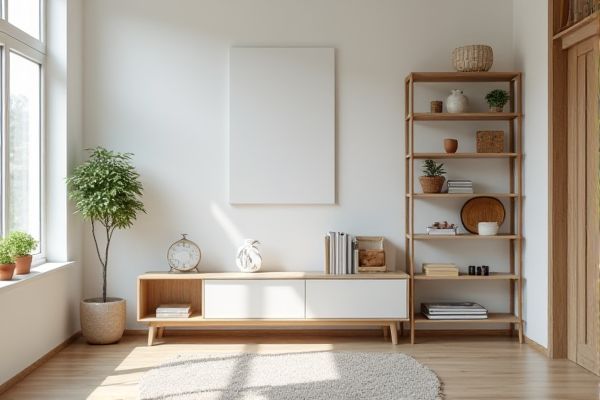
Choosing between a hanging shelf and a free-standing shelf depends on your space, style preferences, and functional needs, offering either wall-mounted elegance or flexible floor-standing storage. Discover which option best fits your home and how to maximize your organization by reading the rest of the article.
Table of Comparison
| Feature | Hanging Shelf | Free-Standing Shelf |
|---|---|---|
| Installation | Mounted on wall, requires drilling | No mounting needed, easy to move |
| Space Efficiency | Saves floor space, ideal for small rooms | Uses floor space, bulkier footprint |
| Weight Capacity | Limited by wall strength and anchors | Can support heavier and larger items |
| Mobility | Fixed in place | Portable and flexible placement |
| Design Options | Typically minimalist, sleek | Variety of styles, sizes, materials |
| Damage to Walls | Potential holes and marks from installation | No wall damage |
| Cost | Generally lower price, but installation tools needed | Varies, often higher price but no installation cost |
Introduction to Hanging vs Free-Standing Shelves
Hanging shelves are mounted directly onto walls, providing a sleek, space-saving storage solution ideal for small rooms and minimalist designs. Free-standing shelves offer flexibility in placement and mobility, suitable for larger spaces and frequent rearrangement. Both types vary in load capacity, installation requirements, and aesthetic appeal, influencing their use in residential and commercial settings.
Design and Aesthetic Differences
Hanging shelves offer a sleek, minimalist design that maximizes floor space and creates a floating effect, enhancing modern and contemporary interiors. Free-standing shelves provide a more versatile aesthetic with various styles like industrial, rustic, or traditional, and serve as statement furniture pieces that can define room zones. The choice between hanging and free-standing shelves critically impacts room openness and visual weight, influencing overall interior harmony.
Installation and Setup Requirements
Hanging shelves require secure wall anchors and studs for installation, making setup more involved and often needing drills, level tools, and precise measurements to ensure stability. Free-standing shelves offer straightforward assembly with minimal tools, often relying on screws or snap-together components to stand independently without wall support. Your choice depends on available wall space, structural support, and whether you prefer fixed or movable storage options.
Space-Saving Capabilities
Hanging shelves maximize space by utilizing vertical wall areas, making them ideal for small rooms or narrow spaces where floor space is limited. Free-standing shelves require floor space but offer greater flexibility in placement and can be moved or rearranged easily to suit changing storage needs. Your choice between hanging shelves and free-standing shelves should consider the available floor area and the importance of optimizing vertical space for your environment.
Weight Capacity and Durability
Hanging shelves typically offer moderate weight capacity limited by wall studs and mounting hardware, making them suitable for lightweight to medium items. Free-standing shelves boast higher weight capacity and enhanced durability due to their robust frame and floor support, ideal for heavy books or appliances. Durability in free-standing units often surpasses hanging shelves, as they resist damage better over time and handle frequent load variations.
Flexibility and Relocation Options
Hanging shelves offer limited flexibility as they require fixed wall installation, making relocation difficult without repair work. Free-standing shelves provide greater adaptability, allowing easy movement and rearrangement in different spaces without damage. Homeowners seeking versatile solutions typically prefer free-standing shelves for their mobility and effortless relocation.
Maintenance and Cleaning Considerations
Hanging shelves require regular inspection of wall anchors and brackets to ensure structural integrity and prevent potential damage or accidents. Free-standing shelves offer easier access for thorough cleaning underneath and around the unit, reducing dust accumulation in hard-to-reach areas. Both types benefit from routine dusting with microfiber cloths and occasional wiping with mild cleaning solutions to maintain surface quality and longevity.
Cost Comparison and Budgeting
Hanging shelves typically cost less due to lower material and installation expenses, making them ideal for budget-conscious projects. Free-standing shelves often require more robust materials and manufacturing, increasing their price but offering greater mobility and storage capacity. Your choice depends on balancing upfront costs with long-term usage and flexibility needs.
Best Use Cases for Hanging Shelves
Hanging shelves are ideal for maximizing vertical space in small rooms, kitchens, or bathrooms where floor space is limited, providing a sleek and modern storage solution. They are perfect for displaying decorative items, plants, or lightweight everyday essentials without crowding the floor area. You can create an organized, clutter-free environment by using hanging shelves in areas where ease of cleaning underneath the shelf is essential.
Ideal Applications for Free-Standing Shelves
Free-standing shelves are ideal for flexible storage solutions in living rooms, offices, and retail spaces where mobility and easy rearrangement are needed. Their versatility allows placement in areas without wall support, accommodating bulky items or decorative pieces. These shelves also suit renters or temporary setups due to their non-permanent installation requirements.
 homyna.com
homyna.com